Croatian Cheeses: An Introductory Guide
March 2, 2022 - When traveling, experiencing a country’s gastronomical delights is at the top of my to-do lists. Food easily reveals a tremendous amount about the country’s culture and customs, reflecting the unique history, identity, values, and beliefs of its inhabitants. This is definitely the case when it comes to Croatia’s culinary heritage.
There is so much to cover when it comes to Croatia’s food scene. Despite the country’s relatively small size, there is an astounding amount of regional variety.
Let’s get into the swing of things by introducing one of my favorite Croatian products - cheese!
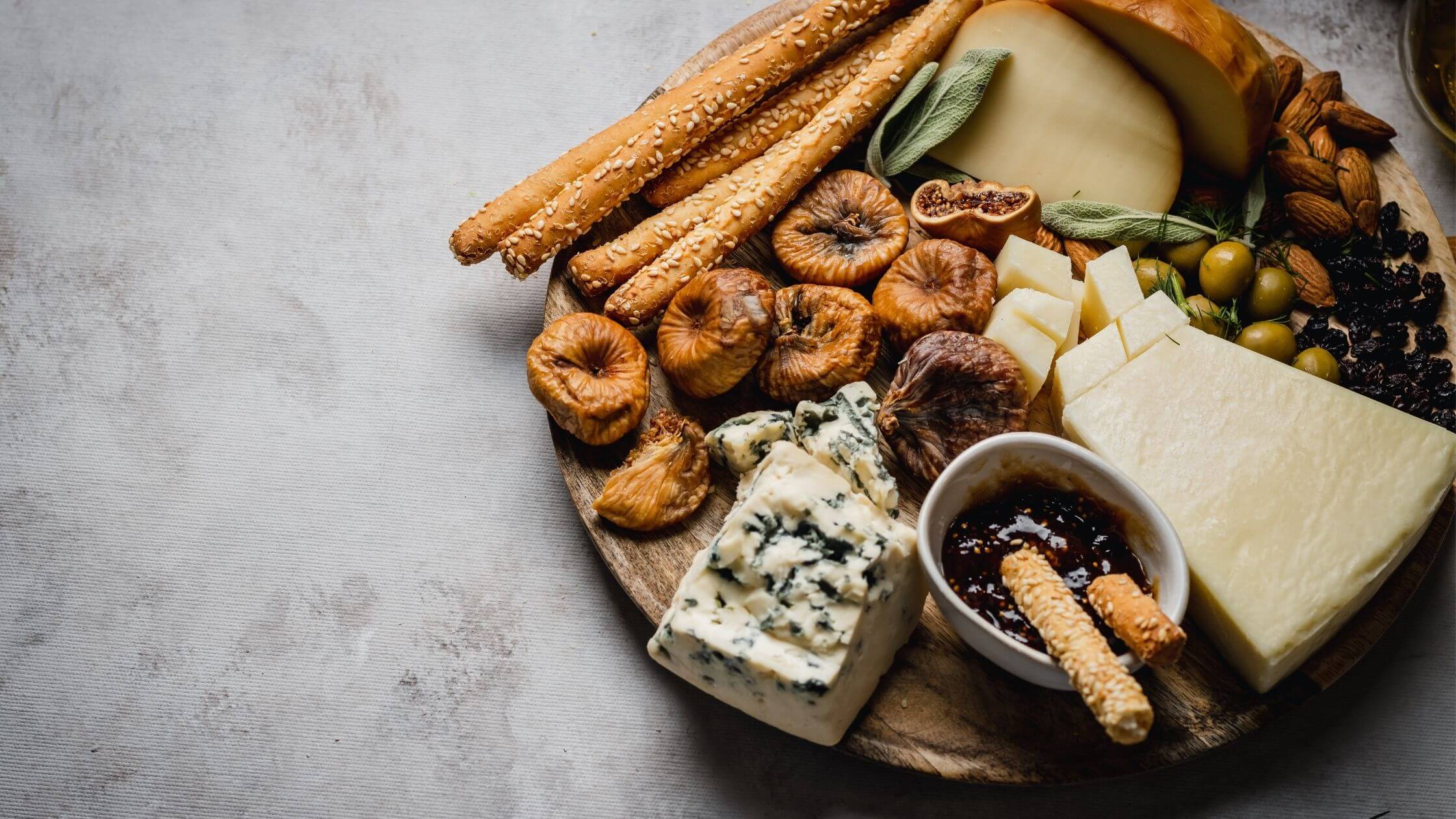
Can't resist a gorgeous cheese plate. Image: Pexels
Oldest cheese found in Croatia
Sir (pronounced s-ee-r), cheese has been an integral part of Croatian history from as far back as 7,200 years, where researchers from Pennsylvania State University found traces of the world’s oldest cheese along the Dalmatian coast.
Although records from the time are scarce, it is theorized that during the 4-5th century BCE, Thracian and Illyrian sheep farmers accidentally produced the first cheeses when milk they kept stored in bags spontaneously fermented and curdled. Today, cheese features heavily in both sweet and savory dishes throughout Croatia such as Burek and Strukli.

Sheep were the dominant livestock for cheese production. Image: Pexels
Yet, on the global culinary scene, Croatian cheeses remained shrouded in relative obscurity due to the lower levels of production, and the disconnect between traditional cheese producers and the international market.
However, this situation started to change when in 2017, Paški sir, a hard sheep’s cheese from the island of Pag with its delectable notes of wild sage and thyme, took home the gold for the best sheep’s milk cheese at the Global Cheese Awards, giving Croatia’s cheeses much-needed recognition.

Paški sir. Image: Gligora/Facebook
In recent years, Croatia has seen the launch of new types of high-quality cheese, as both artisanal and industrial producers continue to experiment with new additions and methods. Don’t be surprised to find both industrially produced cheese, alongside homemade cheese, on the tables of Croatian families.
Croatian cheese galore
This might come as a surprise but despite its small production, Croatia still boasts a mind-boggling variety of delicious cheeses like Škripavac, Tounjski, Creski, Sir iz mješine, Prgica, Lećevački, and Basa, just to name a few!
These cheeses are typically made from goat (kozji), sheep (ovčji), cow’s (kravlji) milk, or a combination of the 3.
Like Croatian food in general, cheese offerings tend to vary between regions but one of the staple cheeses that can easily be found on the shelves of every grocery store is svježi sir, or fresh cheese.
Svježi sir is typically associated with the regions of Zagorje and Prigorje, about an hour's drive north of Zagreb. This creamy, delicate soft cheese is often consumed at breakfast and is made by processing cow’s milk which gives it its signature mild tanginess, comparable to greek yogurt.
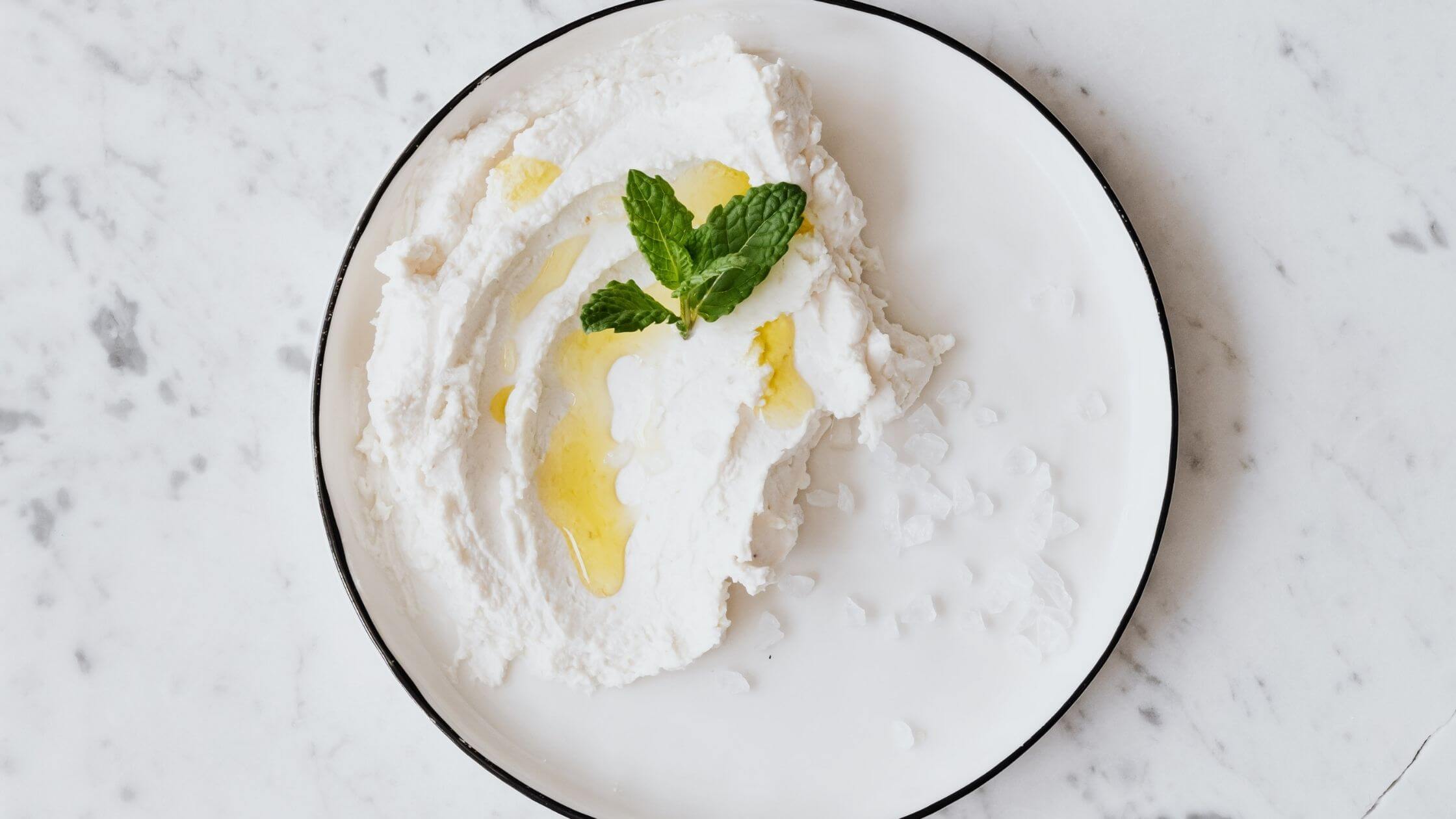
Svježi sir, Croatia’s unsung hero of cheese. Image: Pexels
Derivatives of Svježi sir also include Posni sir, a low fat, smooth, spreadable version, and Zrnati sir which has a grainy texture that most closely resembles cottage cheese. More recently, Icelandic Skyr has also found local popularity due to its high protein, low-fat content. Although consumed like yogurt, Skyr is actually a sour milk cheese.
Another type of Croatian cheese that is commonly sold at farmers' markets is what is known as Kuhani sirevi, or cooked cheese.
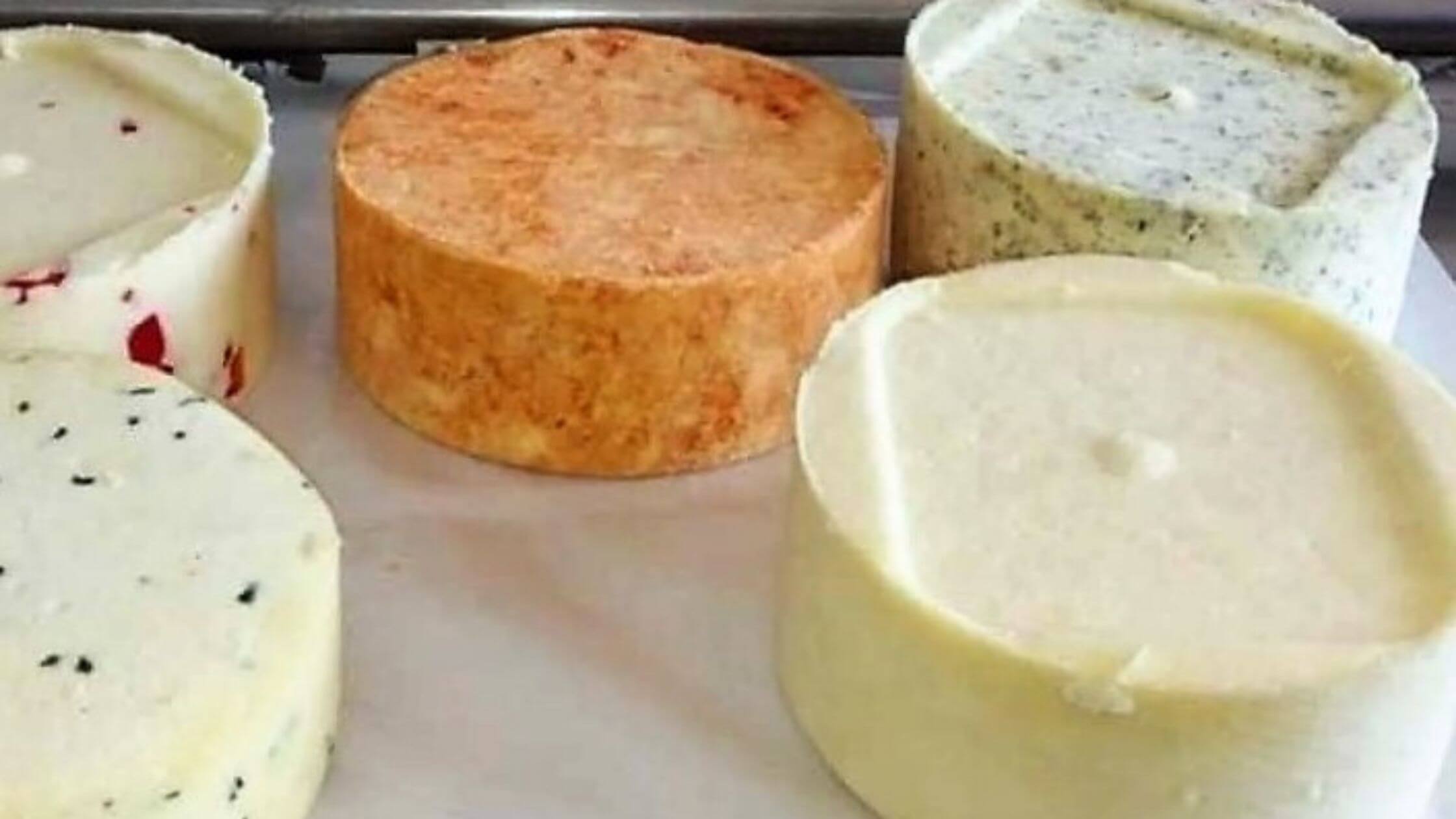
Different types of Kuhani sirevi. Image: Mate Bojčić/Facebook
Kuhani sirevi gets its name from the preparation method where cow’s milk is boiled (i.e. cooked) and curdled with vinegar, before the addition of salt and various spices such as paprika, basil, dill, and oregano.
The result is a semi-hard, rich cheese with a mild chew that when eaten on its own, has a sweet, clean, and grassy flavor. Some producers also smoke this cheese to produce a variant called Dimljeni sir, giving the cheese a delightful smoky aftertaste.
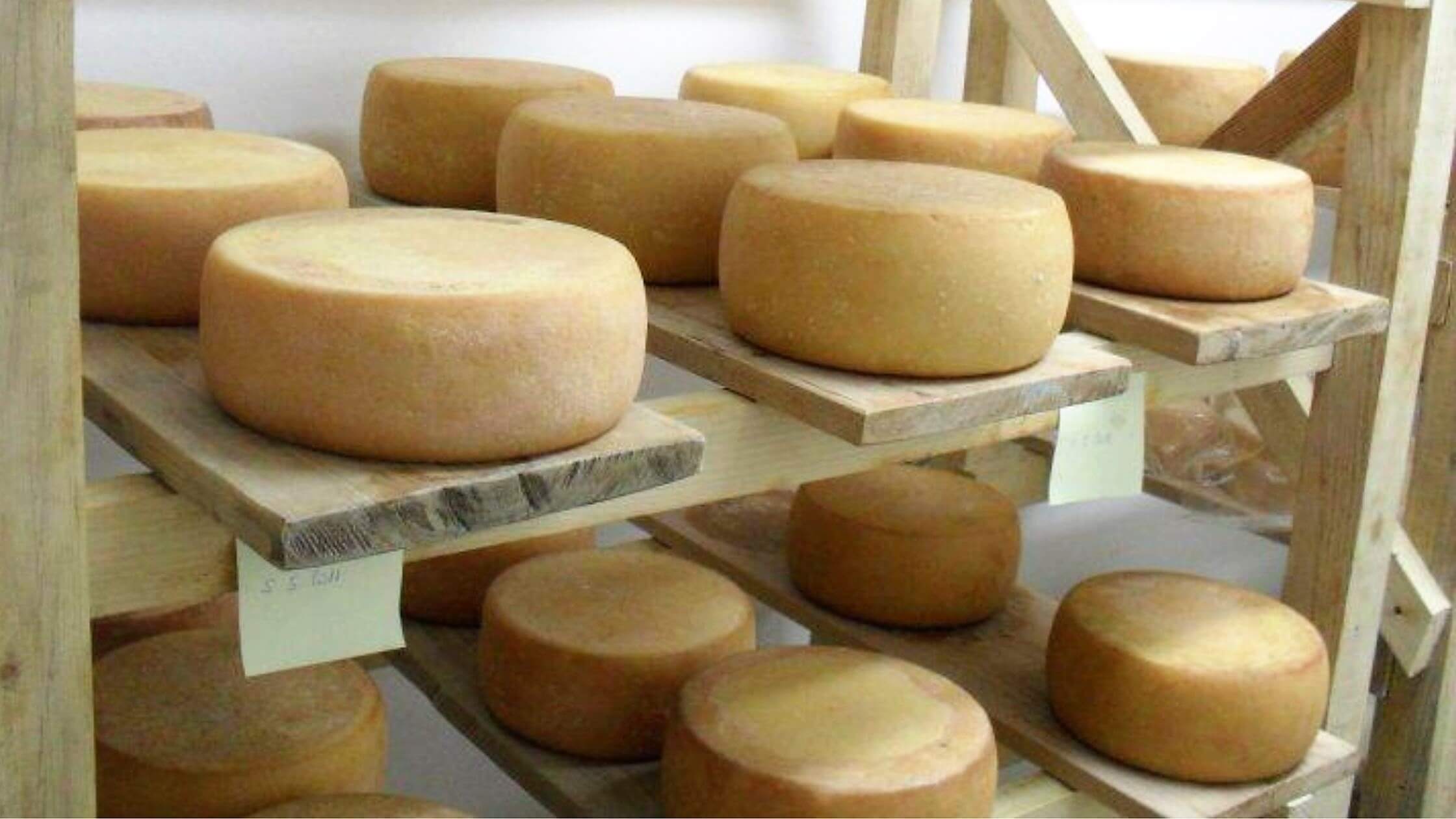
Aging Lećevački cheese. Image: Njuškalo.hr
Closer to (my) home, Lećevački sir may be one of the most widely recognized Dalmatian hard cheeses, having won several awards in the past. In fact, it was so well-received even back in the day that it was served in the Court of Austrian Emperor Francis Joseph (1848-1850).
This cheese originates from the Split hinterland and is made from the milk of either cow, sheep, or a mix of both. It has a mild, grassy aroma with a sharp, slightly spicy aftertaste as a result of the Mediterranean herbs (e.g. rosemary, thyme, sage) that the livestock graze on. Some culinary enthusiasts have even likened aged Lećevački sir, to Paški sir with its nutty notes and crunchy flavor crystals.
Sir iz mišine is a cheese produced in the regions of Zadar, Šibenik, Split and Dubrovnik. Sir iz mišine used to be made exclusively from surplus sheep’s milk, but is today produced with a mix of goat and cow milk.

Sir iz mišine, sold from its lambskin sack. Image: Njuškalo.hr
What makes this cheesemaking process unique is that the milk is aged in lambskin sacks (mišina), made from 6-month-old lambs. When the cheese is ready in the fall, it is transported and sold from these same lambskin sacks. This aging technique also imparts a distinct earthy aroma to the cheese, which is often used as an ingredient to flavor various dishes.
Unfortunately, this cheese is becoming more scarce since the process is kept alive by only a handful of cheesemakers in the region, so do try it if you chance upon it in a market.
Last but not least, there is Težački sir. Težački sir is a hard pasteurized Dalmatian cow milk cheese, aged for a minimum of 4 months. Some producers use this cheese to produce other varieties such as Težački Iz Maslinove, where the same cheese is aged for at least 6 months in pressed olive skins. As the wheels age, the cheese absorbs the flavor and aroma of the olives.
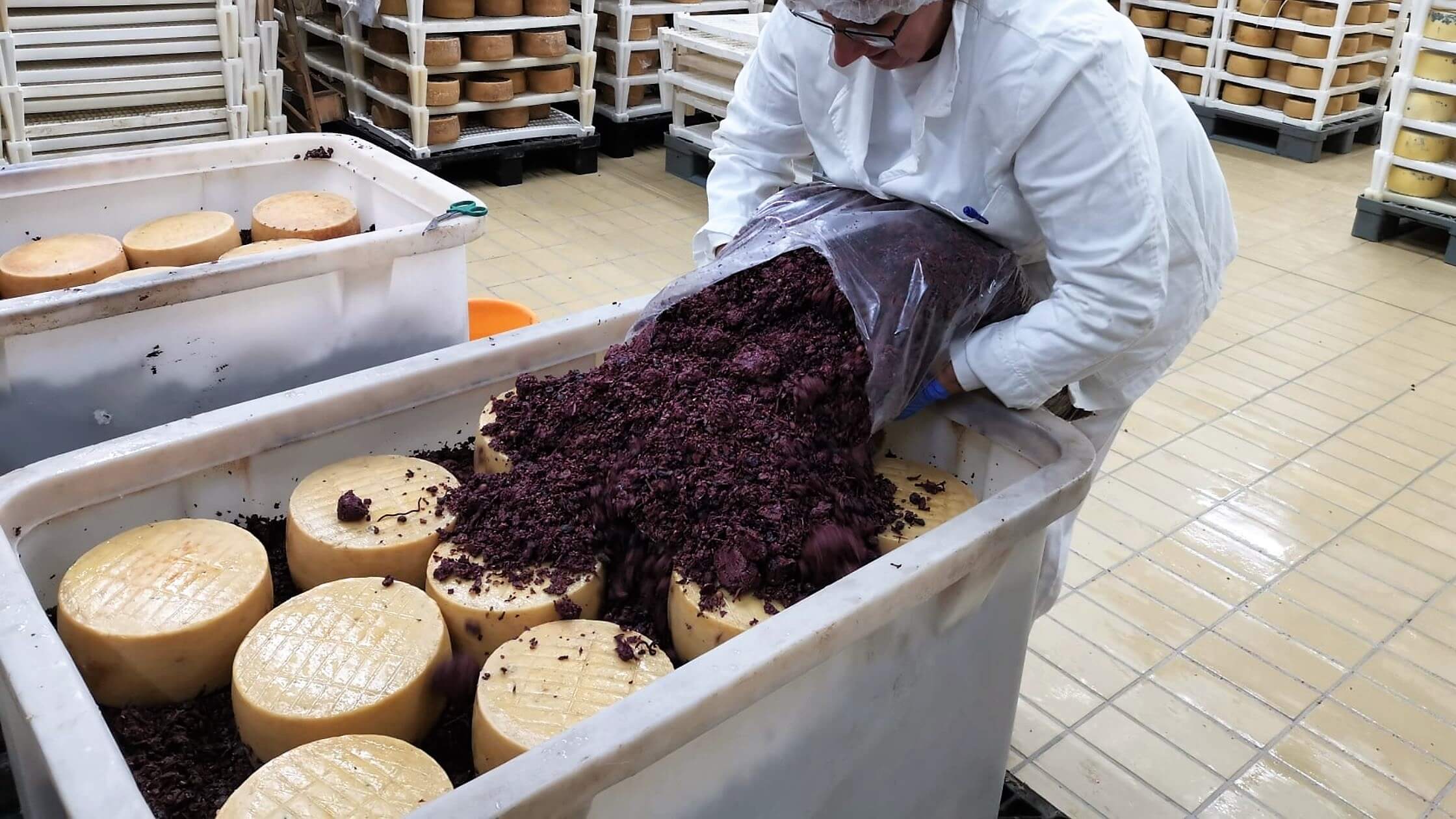
The making of Težački Iz Maslinove at Gligora. Image: Gligora/Facebook
BONUS! How to get the best of both worlds with a method of storing cheese that is unique to the area of Dalmatia and surrounding islands. Semi-hard cheeses are diced into cubes and stored in earthen, or glass containers filled to the brim with olive oil. This way, you get to try the best of Dalmatian cheese and the region’s luscious olive oil.

Sir u ulju, cheese preserved in olive oil for the best of both worlds! Image: My Tasty Pot/YouTube
A quick note on pasteurization
Some Croatian cheeses, in line with European cheese production standards, are made from “raw”, unpasteurized milk that comes straight from the animal. This process is forbidden and/or highly restricted by countries such as Canada, Australia, and the U.S.
Check for labels stating that the product is pasteurized - pasterizirano, or pasteurized and homogenized - pasteriziran i homogeniziran, or if you’re in a restaurant, ask staff for clarity on this.
All in all, I hope this short guide will help you traverse some language barriers and uncertainties when it comes to trying a slice of Croatia’s culinary wonders. Dobar tek!
For more on Croatian products, producers, companies, and exports, make sure to check out Made in Croatia.
Best Croatian Restaurants in 2021 Receive Michelin Awards
October 15, 2021 - The Croatian National Tourist Board and METRO, Michelin's official partner for Croatia, presented the prestigious Michelin awards to the best Croatian restaurants included in the Michelin 2021 guide at a ceremony organized at the Belaj Castle in Istria.
The Croatian National Tourist Board and METRO, Michelin's official partner for Croatia, presented the prestigious Michelin awards to the best Croatian restaurants included in the Michelin 2021 guide at a ceremony organized at the Belaj Castle in Istria, reports HrTurizam.
Recall, this year 10 local restaurants earned stars, three more than last year, this globally most important and most recognized restaurant guide. Among the best Croatian restaurants featured are: Agli Amici Rovinj from Rovinj, Alfred Keller from Mali Lošinj, Nebo from Rijeka are the new Michelin star winners, while Boškinac from Novalja, Draga Di Lovrana from Lovran, LD Restoran from Korčula, Monte from Rovinj¸ Noel from Zagreb, Pelegrini from Šibenik and restaurant 360 from Dubrovnik kept their Michelin star.
A total of 55 restaurants deserved Michelin's recommendations for 2021, while the list of winners of the Bib Gourmand award, which is given for a great price-quality ratio, included 13 Croatian restaurants.
“With more than 100 years of experience in restaurant selection, Michelin’s guide is today an international reference for fine dining and therefore the undeniable importance of such a single recognition for our gastronomy. We realize that creating great cuisine is a tough sport: always competitive, always challenging. Therefore, our partnership with Michelin confirms our desire to be the preferred partner of the HoReCa sector. We create unique products under the brands Metro Chef and Metro Professional: they are designed and perfected together with chefs - made for the best chefs in the world'', said Imre Horváth, President of the Management Board of METRO Croatia.
The importance of Michelin recognition in the development of the domestic gastronomic and tourist offer has been recognized for years by the Croatian National Tourist Board, which was once again a partner of the event.
"Tourism and gastronomy are closely related tourist products, so the awarding of prestigious MICHELIN labels to Croatian restaurants is of great importance in the further promotion and positioning of Croatia as a quality destination with a rich and diverse gastronomic offer. With this award ceremony in the beautiful Istrian ambiance, together with our partners, we want to further emphasize the exceptional success of our recognized restaurants, which were included in MICHELIN's guides and received great honor and recognition for their work. Today, our country boasts a total of 10 restaurants with a MICHELIN star and a total of 68 restaurants with some of the labels of this prestigious gastronomic guide", said the director of the Croatian Tourist Board Kristjan Stanicic, adding that all Croatian regions are rich in diversity, which makes our country recognizable. as a prominent European gastronomic destination.
For more, make sure to check out our lifestyle section.
Gastronomy Contest for Disabled to Be Held in a Few Croatian Cities
ZAGREB, 23 Aug 2021 - The first national gastronomy contests for disabled people above 17 will be organized in several Croatian cities in September and October, and the competition called "Amor Spoon" is organized by an association of teachers in schools for catering occupations and Conventual Franciscans in the country.
Participants will take part in the contest in seven cities: Sisak on 9 September, Vinkovci on 12 September, Novi Marof on 16 September, Pula on 19 September, Šibenik on 23 September, Split on 26 September, and in Zagreb from 1 to 3 October.
They can choose one of a few events in which they can compete: cooking, food serving, and preparing cocktails and drinks.
The most successful participants will be offered to attend free-of-charge workshops within the CookLook project of inclusivity and trips to Rome.
The contest has been so far supported by many associations, NGOs, and centers for rehabilitation said the association of teachers in schools for catering occupations (UNUO) on Monday.
For more on lifestyle in Croatia, follow TCN's dedicated page.
Eat Your Way Through Croatia: The Croatia Michelin Guide for Foodies 2021
July 01, 2021 - Ranked as the 4th most underrated foodie destination in the world, Croatia now boasts 7 Michelin stars, 10 Bib Gourmands, and 51 Michelin Plates restaurants. This is your ultimate food guide for an unforgettable gourmet Croatia experience! The Croatia Michelin Guide for foodies this year.
Originally a guide for French motorists started by brothers Edouard and Andre Michelin back in the early1900s, The Michelin Guide is now the Oscars of the culinary world and the holy creed for ardent food lovers. Although the star system is the most revered and famous among others, the Michelin stars are not the only way the Michelin Guide recognizes restaurants - they also give out the Michelin Bib Gourmand and The Plate Michelin awards to those deserving to be distinguished in the culinary world!
THE MICHELIN GUIDE CROATIA 2021
Find your way to the best restaurants and konobas in Croatia with just one click!
1 Michelin Star - "A very good restaurant; worth a stop!"
2 Michelin Stars - "Excellent cooking; worth a detour!"
3 Michelin Stars - "Exceptional cuisine; worth a special journey!"
Other Awards:
Michelin Bib Gourmand - "Good quality and good value cooking"
The Plate Michelin - "Good cooking: Fresh ingredients and carefully prepared"
SPLIT-DALMATIA
The Plate Michelin
Zoi - Split, Mediterranean Cuisine
Zrno Soli - Split, Seafood / Mediterranean Cuisine
Dvor - Split, Mediterranean Cuisine
Kadena - Split, International Cuisine
Konoba TRS - Trogir, Meditteranean Cuisine
Jeny - Tucepi, Modern Cuisine
Michelin Bib Gourmand
Konoba Škoj - Isola di Solta, Mediterranean Cuisine
ŠIBENIK-KNIN
1 Michelin Star
Pelegrini - Šibenik, Modern Cuisine
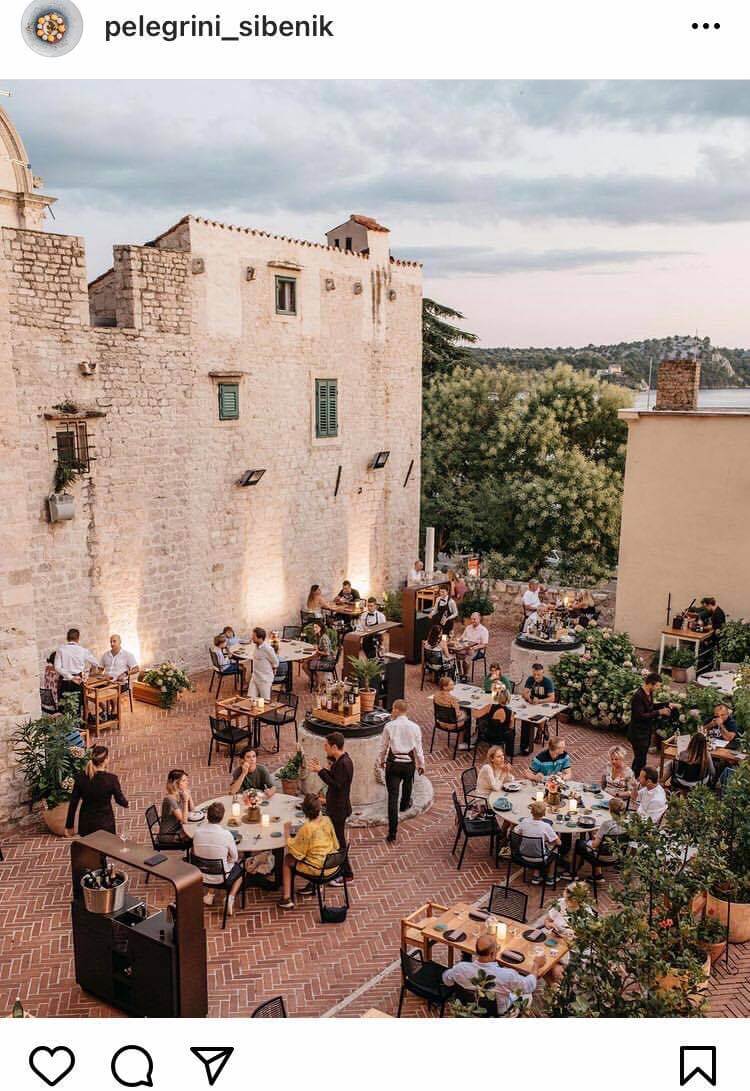
Photo credit: Instagram: pelegrini_sibenik
The Michelin Guide describes chef Rudolf Štefan's menu as perfect and a result of long, painstaking research and hard work. Pelegrini highlights the usage of local ingredients such as oysters, sea snails, sea urchins, mussels, lamb, and veal.
MUST TRY!
- Carrot mussels and sausage
- Chicken tingul
- Fig and ricotta
The Plate Michelin
Konoba Tri Piruna - Vodice, Modern Cuisine/Contemporary
Konoba Boba - Murter, Modern Cuisine
Michelin Bib Gourmand
Konoba Vinko - Konjevrate, Country Cooking
ZADAR
The Plate Michelin
Fośa - Zadar, Seafood and Classic Cuisine
Kaštel - Zadar, Meditteranean Cuisine, Contemporary
DUBROVNIK-NERETVA
1 Michelin Star
Restaurant 360 - Dubrovnik, Modern Cuisine
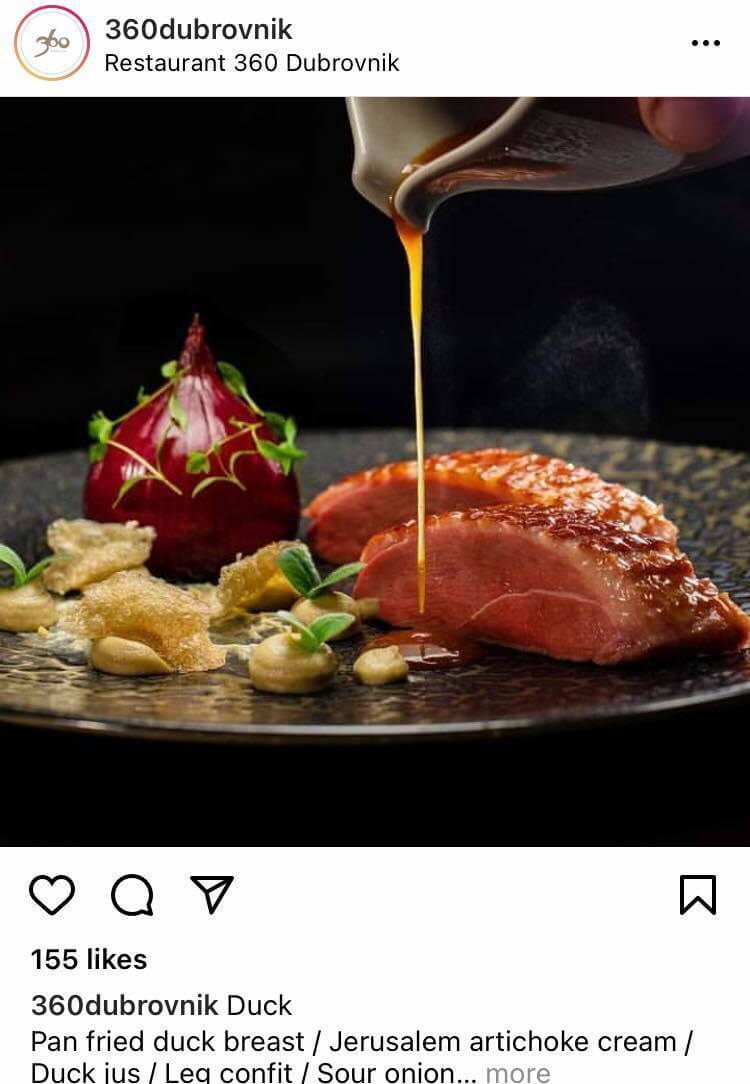 Photo credit: Instagram: 360dubrovnik
Photo credit: Instagram: 360dubrovnik
A restaurant with a perfect view of the picturesque and historical city of Dubrovnik, the restaurant is equipped with real professionalism and young and dynamic staff. The menu is elaborately prepared and beautifully presented, including the wines. The Michelin Guide describes it as the best choice for an enchanting and gourmet evening in this romantic city.
MUST TRY!
- Two textures of scallops and turnip: turnip creamy base with slightly seared scallops, sour turnip disc, and marinated scallops carpaccio in lime juice, crunchy quinoa chips, and thick onion soup
- Pan-seared duck breast, soy sauce glaze, Jerusalem artichoke purée, sour onion filled with duck confit, croutons, and anchovies foam
- Milky chocolate velouté base, Kadaif filled with cooked pear in timut pepper and vanilla, Tonka cream, homemade vanilla, and oat ice cream
LD Restaurant - Korčula Island, Mediterranean / Modern Cuisine

Photo credit: Instagram: lesic.dimitri.palace
This restaurant offers superb Mediterranean cuisine showcasing local products, especially olive oil, excellent fish selection, and exotic ingredients. The outdoor area is perfect for al fresco dining and has the perfect view of the sea and the islands.
MUST TRY!
- Foie Gras (Apple, grapes, brioche crumbs, cherries)
- Prawn gyoza (Mousseline sauce, chili, daikon, sesame)
- Chocolate Crocante
The Plate Michelin
Vapor - Dubrovnik, Modern Cuisine
Nautika - Dubrovnik, Classic Cuisine
Above 5 - Dubrovnik, Creative
Stara Loza - Dubrovnik, Mediterranean Cuisine
Proto Fish - Dubrovnik, Seafood
Dubrovnik - Dubrovnik, Mediterranean Cuisine
Bistro Tavulin - Dubrovnik, Traditional cuisine
Pjerin - Dubrovnik, Mediterranean Cuisine
Bugenvila - Cavtat, Classic Cuisine
Filippi - Korčula Island, Mediterranean Cuisine
Michelin Bib Gourmand
Konoba Mate - Korčula Island, Country Cooking
ISTRIA
1 Michelin Star
Monte - Rovinj, Creative

Photo credit: Instagram: monte_rovinj
The Michelin Guide describes Chef Danijel Dekić's cuisine as highly creative, almost theatrical with contemporary and exciting techniques. Monte is located in the heart of Rovinj, with a modern and trendy vibe. Definitely worth a stop!
MUST TRY!
- Omega 3- three preparations of Northern Adriatic fish
- Suckling pig, lentils, yellow cabbage, pork rind
- Apple & Rose- rose ice cream, apple mousse, candied rose petals
The Plate Michelin
Alla Beccaccia - Valbandon, Traditional/Classic Cuisine
Meneghetti - Bale, Classic Cuisine
La Puntulina - Rovinj, Mediterranean/Regional Cuisine
Zigante - Livade, Traditional Cuisine
SV. Nikola - Porec, Classic Cuisine
Konoba Čok - Novigrad, Seafood
Marina - Novigrad, Creative
Damir & Ornella - Novigrad, Seafood
Konoba Morgan - Brtonigla, Traditional Cuisine
San Rocco - Brtonigla, Contemporary/Modern Cuisine
Badi - Lovrečica, Meditteranean Cuisine
Konoba Buščina - Umag, Traditional Cuisine
Pergola - Zambratija, Seafood
Michelin Bib Gourmand
Batelina - Banjole, Seafood
PRIMORJE-GORSKI KOTAR
1 Michelin Star
Draga Di Lovrana - Lovran, Modern Cuisine
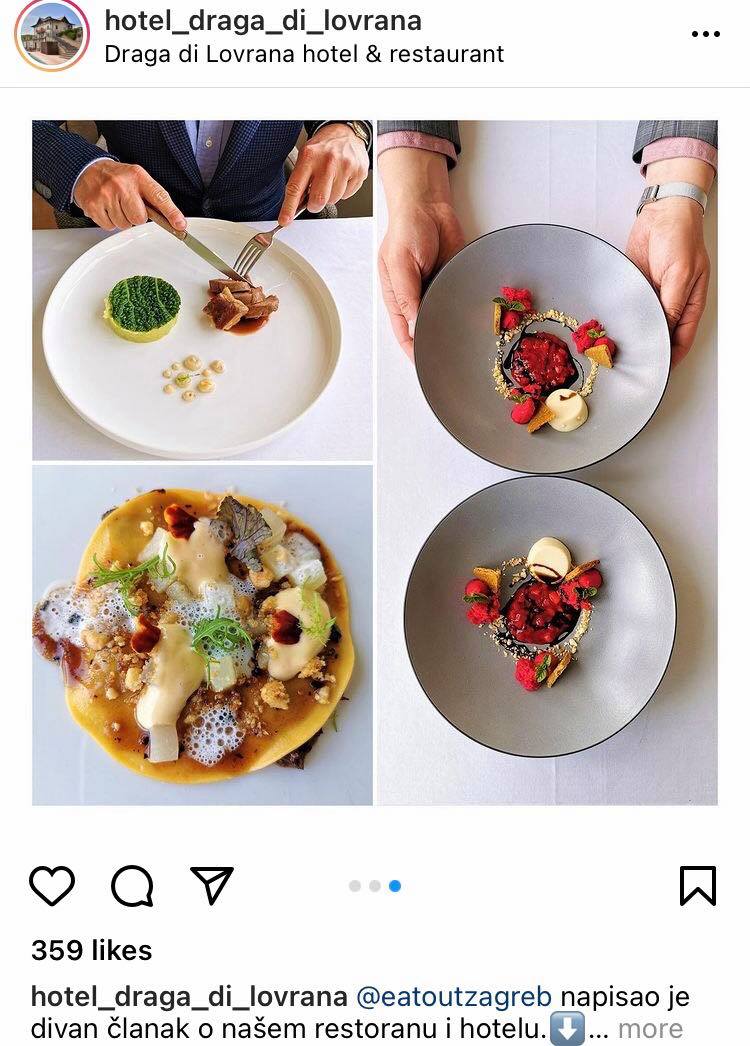
Photo credit: Instagram: hotel_draga_di_lovrana
The Michelin Guide commended the restaurant's promotion of local produce and its dishes that are creative, modern with Mediterranean influences and occasional French twist. The restaurant has an impressive wine list that perfectly complements the restaurant's daily menu. Since 2021, this modern kitchen is being run by chef Zdravko Tomšić.
MUST TRY!
- Rolls of deer ramsteak, mousse pastrnjaka, carrot, pomegranate
- Pork belly, Roman gnocchi, beet chutney / apple
- Whiskey biscuits, baked pear cream, mandrine sauce
- Kvarnerski ceviche, orange emulsion, black basket
The Plate Michelin
Villa Ariston - Opatija, Classic / Modern Cuisine
Navis - Opatija, Contemporary / Mediterranean Cuisine
ZAGREB
1 Michelin Star
Noel - Zagreb, Modern Cuisine
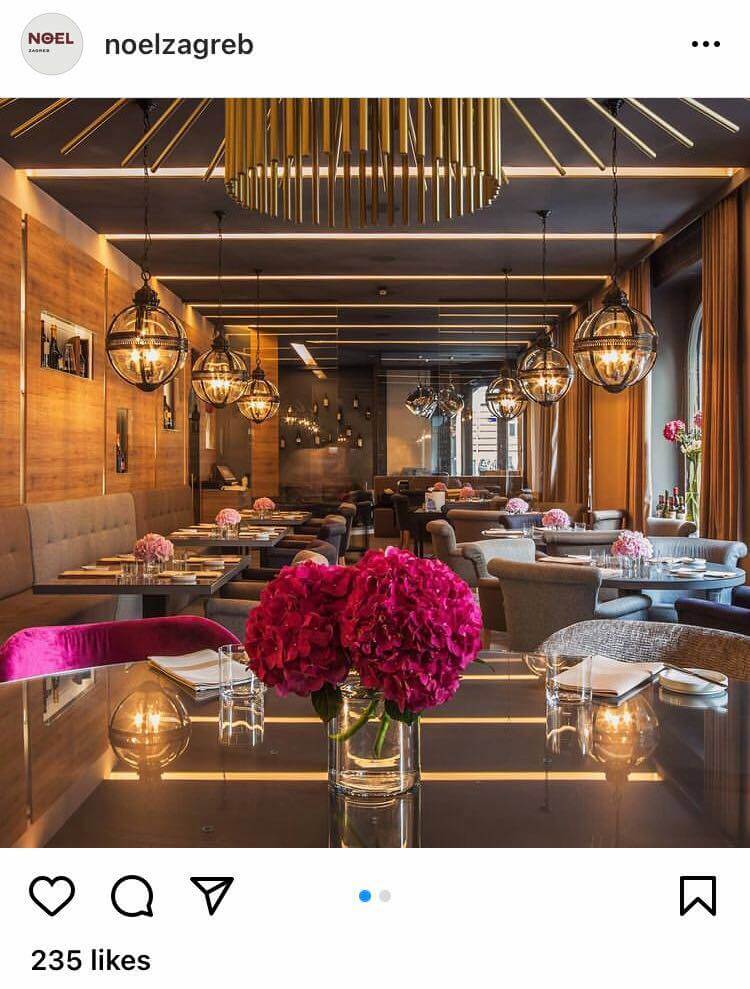
Photo credit: Instagram: noelzagreb
The restaurant serves contemporary, modern, and imaginative dishes with carefully selected Croatian, French and Italian wines. This trendy and hip restaurant is owned by owner-chef Goran Kočiś and his business partner and sommelier, Ivan Jug.
MUST TRY!
- Zagorski Štrukli with Istrian truffles
- Wild fish, young beans, yuzu, beurre blanc
- Apple, rosemary, passion fruit
The Plate Michelin
Tekka - Zagreb, Japanese/Asian, Takeaway
Zinfandel's - Zagreb, Modern Cuisine
Le Bistro Esplanade - Zagreb, French
Beštija - Zagreb, Market Cuisine / Contemporary
Apetit - Zagreb, Mediterranean Cuisine
Takenoko - Zagreb, Japanese / Fusion, Takeaway
Boban - Zagreb, Traditional Cuisine
Pod Zidom - Zagreb, Market Cuisine
Dubravkin Put - Zagreb, Mediterranean Cuisine
ManO - Zagreb, Steakhouse / Modern Cuisine
Bistro Apetit by Marin Rendić - Zagreb, Mediterranean Cuisine
Mon Ami - Velika Gorica, Mediterranean Cuisine, Takeaway
Michelin Bib Gourmand
Agava - Zagreb, International
Tač - Zagreb, Traditional Cuisine
KRAPINA-ZAGORJE
Michelin Bib Gourmand
Vuglec Breg - Krapina, Regional Cuisine
LIKA-SENJ
1 Michelin Star
Boškinac - Novalja, Pag, Modern Cuisine
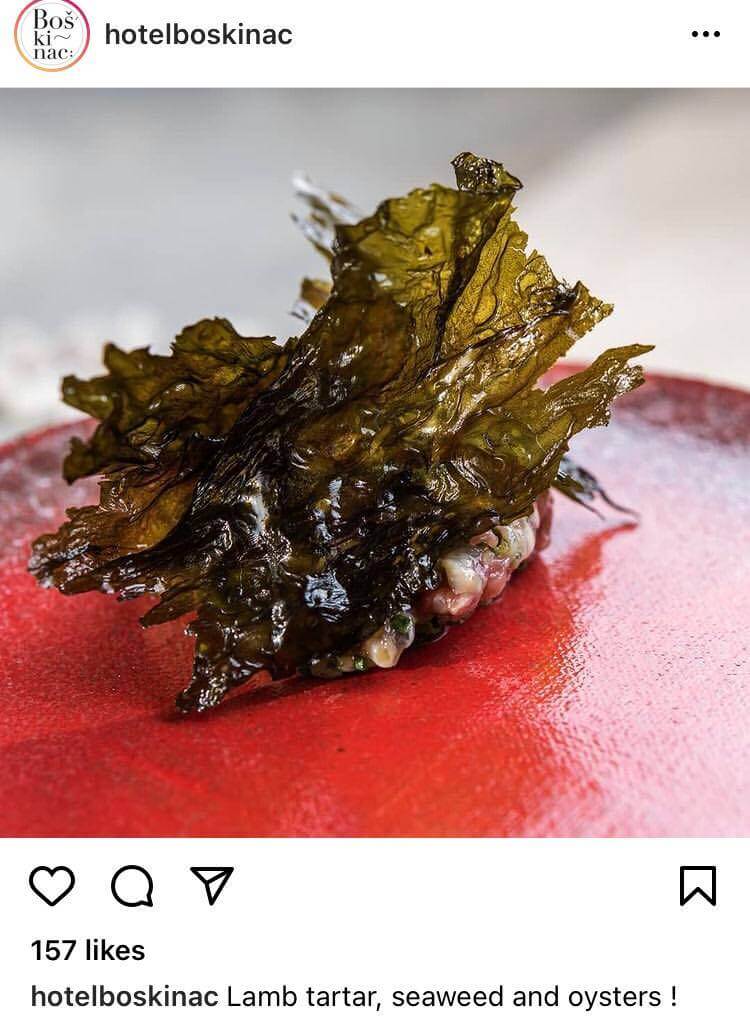
Photo credit: Instagram: hotelboskinac
Surrounded by greenery, Boškinac showcases Pag island's various delicacies in its menus such as olive oil, Pag cheese, lamb, fish, and wine. The restaurant is located in a property that is perfect for an idyllic and relaxing holiday in Croatia.
MUST TRY!
- Scampi, seaweed, basil and almond emulsion, planktons
- Pag lamb burned with pine needles powder, roasted lamb belly, peas, and mint cream, pickled carrots
- Beetroot cream, fermented lemon and yogurt cream, olive oil sponge cake cover, beetroot jelly, pickled carrot leaves
VARAŽDIN
The Plate Michelin
Bedem - Varaždin, Traditional Cuisine, Takeaway
Michelin Bib Gourmand
Zlatne Gorice - Varaždin Breg, Regional Cuisine
MEDIMURJE
The Plate Michelin
Mala Hiža - Mačkovec, Regional Cuisine
OSIJEK-BARANJA
The Plate Michelin
Waldinger - Osijek, Regional Cuisine
VUKOVAR-SYRMIA
Michelin Bib Gourmand
Dunav - Ilok, Country Cooking / Regional Cuisine
For more on travel in Croatia, follow TCN's dedicated page.
For more about Croatia, CLICK HERE.
Croatia Ranks 4th in Undiscovered Gastronomic Destinations in World
November 17, 2020 – Croatia receives another gastro recognition as the gastro portal Chef's Pencil has declared it as one of the best undiscovered gastronomic destinations in the world.
As Večernji list reports, it is a competition named "The Most Underrated Foodie Destination in the World" conducted among 250 renowned chefs and culinary experts, who singled out under-exposed gastro destinations that can stand alongside popular gastro destinations such as France and Italy.
They selected the top 10 countries that can boast of their gastronomic offer and wealth but are not widely-known as gastro destinations. Croatia took a high fourth place on this list, behind the Philippines, Vietnam, and Mexico. It is followed by Thailand, Peru, Australia, Jamaica, Portugal, and Norway.

Screenshot Chef's Pencil
"Croatia has become a really popular place to holiday over the last few years. And who can blame all those holidaymakers for reaching for pristine Adriatic waters, spectacular beaches, sublime Mediterranean climate, atmospheric Roman ruins, incredible national parks, and soaring mountains… Have I mentioned the food yet? And maybe that’s why it’s an underrated foodie destination – the country has so much going for it, the food has to fight for attention," they say from Chef's Pencil about the Croatian cuisine, noting that it's hard to pinpoint it as it varies from region to region.
"Dalmatian food is typically Mediterranean with lots of fish, veggies, and olive oil. Istrian cuisine is similar although they have their own special approach to beans and pasta here. In Zagreb there’s more of a European vibe with meat and a special attachment to cabbage, while in Slavonia its pork and more pork and lots of paprika," they explain, naming some of the best Croatian food such as sheep's cheese, cured ham, black risotto, octopus salad, brudet, sarma, and more.
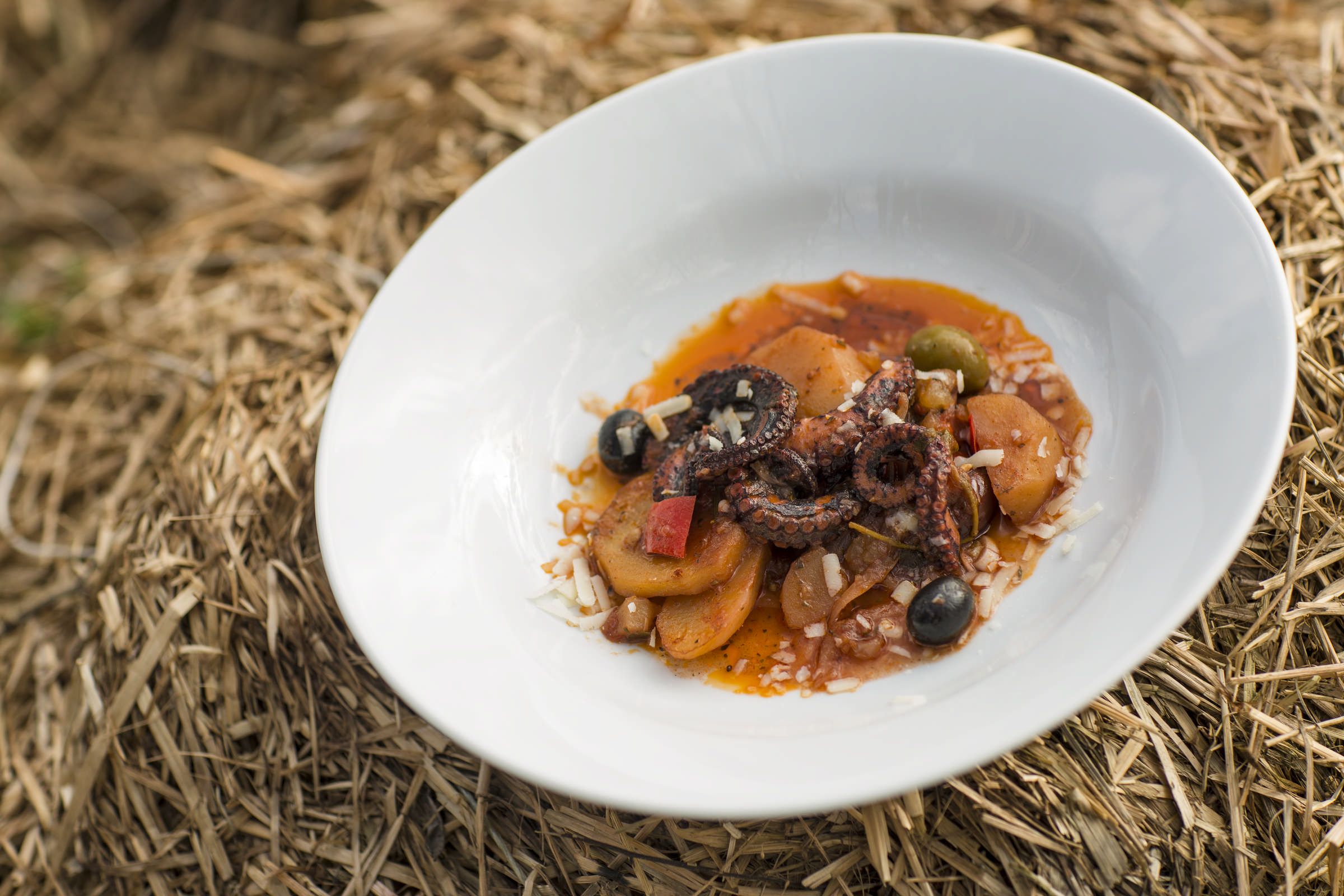
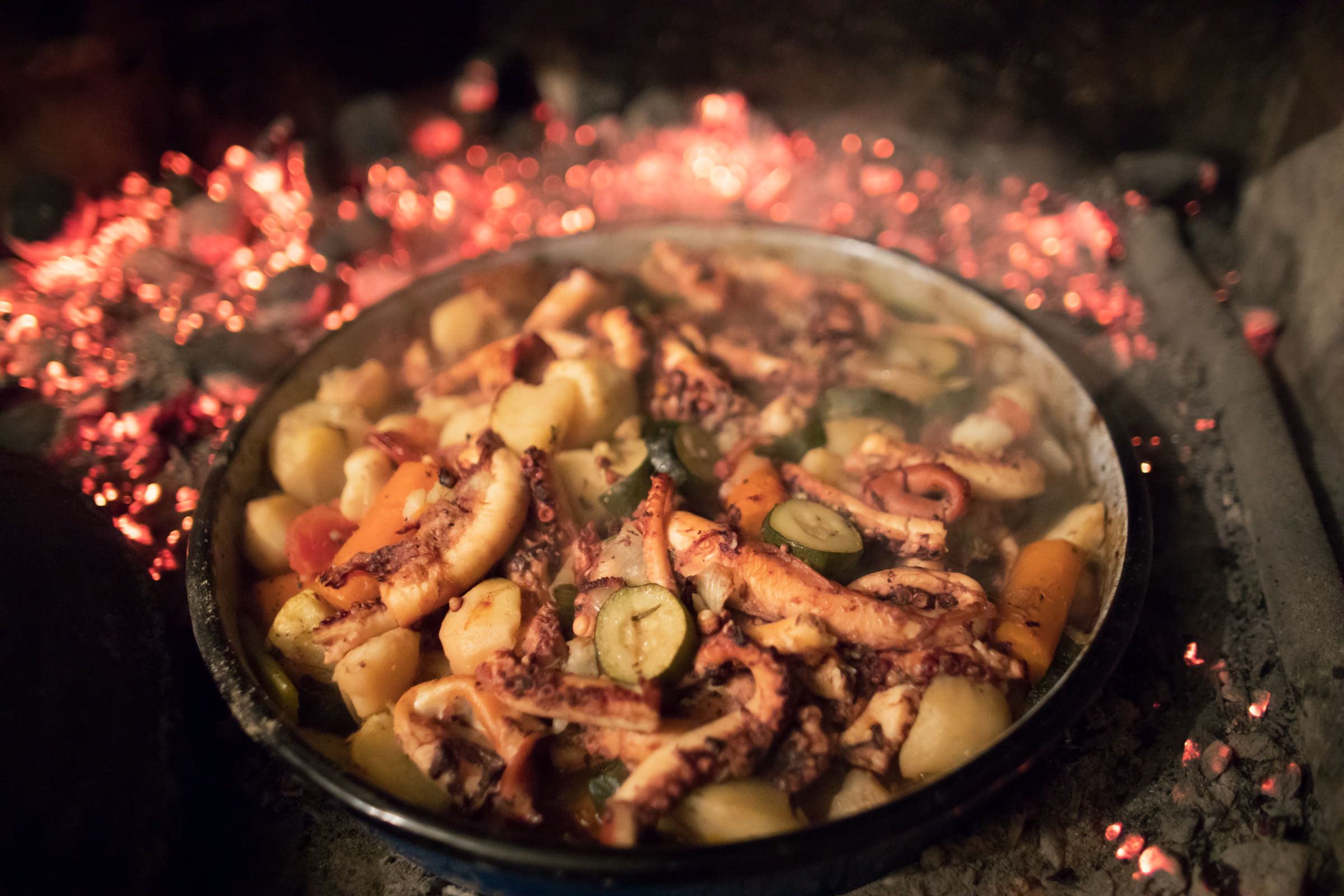
Octopus salad / Copyright Romulić and Stojčić
Although Croatia is already recognized for its gastronomic excellence, offering unforgettable gastronomic experiences for all food lovers, chefs, and experts who participated in the survey believed that our country deserves additional international recognition.
"Recognitions like this give us an additional incentive to continue the development of our gastronomic scene and to continue to promote ourselves as an attractive and quality gastronomic destination, which we really are," said Croatia National Tourist Board director Kristjan Staničić.
Recall, in 2020, the Croatian National Tourist Board presented Croatian gastronomy on this renowned portal, as well as Croatian chefs and regional gastronomic specialties.
Kvarner was presented by the youngest Croatian chef with a MICHELIN star, Deni Srdoč, who shared with readers a recipe for a lamb dish "Heritage lamb". Marko Gajski, the chef of LD Terrace in Korčula, who was also awarded a MICHELIN star this year, presented the Dalmatian region through his original recipe for Komiža bread, while chef Bruno Vokal from Noel, Zagreb's first MICHELIN star restaurant, shared his original recipe for "Deconstructed štruklji". Marina Gaši, chef and owner of the family restaurant Marina in Novigrad, presented the flavors of Istria via sardine tartare. The story of Croatian gastronomy was concluded by Tomica Đukić, chef of the Osijek Hotel and official chef of the Croatian national football team, who presented the rich flavors of Slavonia with a flavored fillet of a black Slavonian pig with pumpkin and beetroot.

Rich gastronomic offer from Slavonia / Copyright Romulić and Stojčić
Croatian Restaurants Say Coronavirus Measures Jeopardize Business
April 24, 2020 — Croatian life began a slow march towards normalcy, with the announcement of incrementally-relaxed restrictions over the coming weeks. Restaurants and cafes claim the government's current plan will tank their business, hoping a return to normal comes sooner than expected.
Dalmatian restauranteurs said in interviews they will not have Plexiglas dividers in their establishments, nor will transparent barriers line their terraces this summer.
The Civil Protection Directorate's 11-point list of anti-coronavirus measures taking force on May 11 will increase costs, sink revenues and ruin guest's experiences, they argue, adding it's not even worth opening.
Most said they would prefer to keep their facilities closed until regulations soften, after which they would respond in two days by opening the facilities.
"Last year, at this time, we already had a lot of work and money," one caterer told Slobodna Dalmacija. "This year, we don't even make plans, everything stops."
The new measures would send operating costs skyrocketing, the source added. "A glass of water with coffee or lunch becomes too expensive for us. Because that glass of water now needs to be disinfected, sterilized. We're destroyed now."
Dalmatian chef Pero Savanović said the measures were unacceptable. In his tavern "Mediteran" in Primosten, guests usually sit packed tightly, with backs nearly touching.
"I cannot agree to the measures that are now set as the ultimatum," he said. "By adopting these XXXL measures, we are in a position of unprofitable business.
"At this time last year we were already working full steam," Savanović added. "This year we will wait until the last moment, hoping that someone above, from the decision-makers, will realize that we cannot work on the guest screening system."
A thinning crowd is just one problem. The added costs make the measures unmanageable. Savanović pegged the cost of plexiglass barriers for his terrace at HRK 100,000.
Still, many hope the coronavirus will subside, borders will reopen and tourists will come. Even in this scenario, Savanovic suggests the domestic guest may be key.
Even in the best-case scenario of all wealthy Croats dropping wads of kunas at every meal, Savanović said he'll have to cut staff. The price of labor will be reduced. Food and drink would be cheaper. And a new value system will be established in the catering market.
Savanovic said the measures are made by robots who are just waiting to have a chip installed. Restaurants do not serve a biological need for sustenance, but a social one. Plexiglass, Savanović said, makes this impossible.
"Even in the best conditions, only family restaurants will survive, and those with a quality offer," he said. "There will be order in the chaos, everything that was created for fast profits, poor quality, bad, will fall out of the game."
Well-known chef Duje Pisac said the coronavirus made an unholy mess. Even the luxury heritage hotel in Brac, which is filled by a deep-pocketed clientele has not opened its doors. If the measures are strict, they probably won't.
"How do you arrange breakfast under such conditions? It's hard," Pisac said. "How do you ensure physical distance at the pool? No way. Measures as they are now, and as announced, are deadly for us hospitality and hospitality workers."
He echoed Savanović's issues with the Plexiglass but also suggested wait staff dressed as surgeons won't help either. "Waiters' gloves? Yes, fine. But masks? I can accept them, but then it's not the same. It immediately alludes to danger, to distress."
Culinary Olympics in Stuttgart: Croatia Returns Home with 12 Medals
February 22, 2020 - Croatian chefs again showed great quality and successfully promoted Croatia at the Culinary Olympics in Stuttgart.
Great news arrives from the recently held Culinary Olympics, where the Croatian culinary team was presented for the fourth time, reports HRTurizam.
The Culinary Olympics is the largest and most prestigious culinary competition in the world, where over thirty Croatian chefs and confectioners in different competitive categories competed this year.
Croatian representatives once again shone among the crowd of competitors, which included more than 2,500 from over seventy countries around the world. Croatia proudly returns home with two team and six individual bronze medals, and four individual silver medals, and their work was followed by over 100,000 visitors who, in addition to culinary competitions, had the opportunity to visit the related gastro fair, which took place in parallel in 10 pavilions.
Croatia participated in two of the most prestigious categories of the competition: "Restaurant of the Nations,” where they won a bronze medal by preparing a 3-course menu in 6 hours for 110 people and "Chefs table" where they prepared 7-course meals for 12 people in 5 hours.
Ivan Djukic won the silver medal in the individual category "Culinary Arts - Classical Thai style carving", while Dražen Šafar won the diploma in the same category. Ivan Djukic also won the bronze medal in the category "Culinary Arts - Carving Live".
The current state champion in confectionery, Sandra Jadek, was brilliant in the individual confectionery category and brought home a silver medal. The Varazdin County Regional Team presented their knowledge and skills in a cold table set consisting of finger food, cold plates, three entrees, a 5-course festive menu, four different desserts, and petit fours and won a bronze medal.
Dinko Tomašić, the young hope of Croatian cuisine, won the silver medal in the individual culinary category. In the same category, Lovro Stancin, the youngest Croatian representative, Antonio Bukvić and Tomislav Sabolić, won the bronze. Antonio and Tomislav were also awarded the bronze in the culinary artist category, where Erich Glavica won the silver. The Chef.hr team was presented in the catering category and received a diploma for its performance.
Over the past year, Croatian contestants have worked tirelessly to present Croatian gastronomy on this large culinary stage.
They made a special effort to emphasize indigenous Croatian foods and successfully promoted Croatia as a gastronomic destination in the country's main tourist market and sent the best invitation to potential tourists.
“The Culinary Olympics, just like the one in sports, is held every four years and requires great renunciation, long and arduous preparation, and each member has given its best to present themselves and Croatia in the best possible light. It was not easy, but it was worth it, because Croatian chefs and pastry chefs brought home new knowledge and skills and a wealth of unforgettable memories in addition to winning medals. They have connected with the best chefs in the world and are motivated to continue working in the profession. They will also apply the newly acquired knowledge in their facilities and pass on to colleagues through various workshops of the Croatian Culinary Academy, thus raising the quality of the catering offer and facilities in Croatia,” the Croatian Chefs Association said.
Norway was named the best and is the new Olympic winner in the National Teams category, while Sweden had the best junior team.
To read more about lifestyle in Croatia, follow TCN’s dedicated page.
Croatia to be Branded as 'Gastronomic Icon of Europe' with New Project
August 14, 2019 - A new project sets out to make Croatia a gastronomic icon of Europe.
Earlier this year, in collaboration with WYG Counseling, the Institute for Tourism and the Institute for Development and International Relations, a major project was completed entitled "Croatia, the New Gastronomic Icon of Europe: A Strategy for the Development of Gastronomy, Gourmet, and Gastronomic Tourism in Croatia with an Action Plan 2019 - 2022," reports HRTurizam.
TCN’s Mario Jukić was at the closing conference of the Gourmet Croatia project back in March, held at the Principovac estate near the easternmost Croatian town of Ilok. There, Neven Ivandić and Neda Telišman Košuta from the Institute of Tourism presented the project and the brochure “Croatia - the New Gastronomic Icon of Europe".
The overall objectives of the project are to link the food processing sector and the tourism sector through establishing local production systems, as well as the territorial branding of Croatia as a recognizable gourmet destination, or, more precisely, a gastronomic destination that enters the top 20 tourist destinations in the world. The strategic document analyzes the current state of gastronomy and gourmet offerings in Croatia, the main market trends in the field of eno-gastronomy, defines the vision of the development of Croatian gastronomy and "gourmet" and is complete with an action plan. The project is co-financed by the European Regional Development Fund.
Interestingly, the contracting authority of the strategy, which is several thousand pages long and has been reportedly working for three years, is the Ministry of Economy, Entrepreneurship and Crafts, not the Ministry of Tourism, which should be responsible for implementing the Action Plan.
The Ministry of Economy, Entrepreneurship, and Crafts turned out to be a mediator between the tourism and agriculture sectors in another story about the merger of the ‘green and blue Croatia’. The strategic brochure states that catering in Croatia is an industry that is developing faster than the economy as a whole, with a growing number of facilities and employees, as well as an increase in revenue and profit in 2016-2018.
However, at the conference back in March, Rudolf Štefan, the chef of the Pelegrini restaurant, spoke about the development of education in the gourmet area. "There are about sixty catering schools in Croatia, huge resources are being spent, but unfortunately, not all of these schools produce good staff. We need one high-quality institution that will create the foundations for high-quality gastronomic future of Croatia.”
Thus, the project brochure explains that the growth of interest in food and beverages reflects profound social changes driven by the improvements in education and prosperity, technology and growing environmental pollution, while the key trends for the development of global gastronomy are experience in buying, sustainability, healthy food, multiculturalism, return to tradition, good-quality fast food and growing media influence. That is the framework that supports further development of gastronomy and gastronomic tourism in the direction of creativity, authenticity and sustainability, concluded Jukić about the project in March.
To read more about travel in Croatia, follow TCN’s dedicated page.
Croatia Airlines Presents New Business Class Menu Promoting Zagreb Cuisine
Croatia Airlines introduced a new menu for business class travelers, which will further promote Croatia's tourist and gastronomic offer, reports AvioRadar on June 12, 2019.
The new gastronomic offer on flights was created by the celebrated Croatian chef Dino Galvagno andLeopold Botteria of Uje Oil Bar, partners with whom Croatia Airlines launched the project ‘Inspired Croatia’ at the end of 2016, in which business class passengers are offered meals prepared using native recipes and ingredients of the coastal and continental Croatia.
The new business class menu, which will be introduced on board on June 19 this year, is primarily motivated by the dishes of Zagreb cuisine such as ham, turkey with mlinci, kale with minced meat, štrukli, and other dishes made from local ingredients which have been used in these areas for centuries and are found in all Croatian kitchens.
“In the selection of meals for the Zagreb menu, I was guided by the idea of creating the ambiance of the Zagreb family table from the beginning to the middle of the 20th century, bearing in mind the strong influence of the Austro-Hungarian cuisine and the wealth of food offered by the nearby rural economy. Zagreb families buy the ingredients for the dishes on our menu at the Dolac market and they are enjoyed almost daily. We want the taste and smells of these dishes to accompany passengers to their new destination,” said Dino Galvagno at the presentation of the menu in Zagreb.
Apart from Zagreb cuisine, the new business class menu also promotes local ingredients from other Croatian regions, such as anchovies, bacon, cuttlefish and broad beans. Additionally, the new meals for business travelers on all Croatia Airlines flights will contain more vegetables and will be prepared by traditional cooking methods with a minimal change in the character of the ingredients. A special challenge in this project was also synchronizing several catering service providers in Croatian airports, specifically in Zagreb, Split and Dubrovnik, to achieve the uniformity of taste and quality.
Other news in the Croatia Airlines’ culinary offer is the new project called ‘Croatia Airlines full of taste’, which is being prepared in cooperation with the Croatian Tourist Board and is expected to start in April 2020.
“Croatia Airlines 'full of taste’ is a project of Croatia’s wine and gastronomy on our airplanes, whose values will be felt by business and economy travelers. We will realize it with renowned Croatian chefs, restaurants, wineries, sommeliers, oil producers, and other Croatian producers of native Croatian products. Every six months, in summer and winter, we will completely change the menus and their visual presentation following the various concepts of the Croatian gastronomic map, to further increase the pleasure of passengers on our airplanes,” said Jasmin Bajić, President of Croatia Airlines Management Board.
As a national carrier and a company that continuously improves service, Croatia Airlines wants to offer added value to passengers within these projects and bring them closer to the gastronomic wealth of Croatia through taste, smell and color, concluded the airline in their announcement.
To read more about travel in Croatia, follow TCN’s dedicated page.


